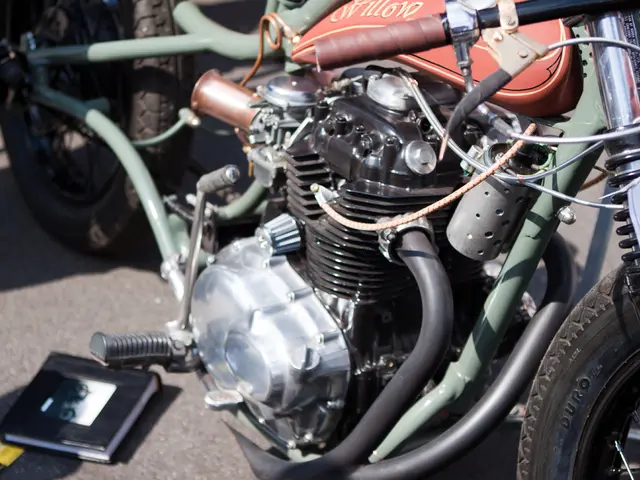Electric Vehicle (EV) Loading System (V2L): Overview and Functionality
Elevating Your Electric!
Float the Power: Welcome to the world of Vehicle to Load (V2L), a revolutionary feature in electric vehicles (EVs) and plug-in hybrid electric vehicles (PHEVs) that lets you share your ride's juice!
Get the Juice Flowing: What does V2L mean? Simply put, it's using your EV or PHEV's high-voltage battery pack to power an external appliance, from laptops and e-bikes to power tools, refrigerators, or even another electric vehicle with a flat battery!
The Green Gearshift: As eco-consciousness grows, electric cars are a perfect match for those wanting to downsize their car and cut costs or optimize renewable energy from a home solar system.
Plugging into Power: To get V2L up and running, just connect an extension cord to your electric vehicle and the appliance you wish to power. Most vehicles offer V2L access via an adaptor fitted to the external charge port or a three-pin socket inside the cabin.
Prices may Vary: Keep in mind that V2L capability isn't standard for all EVs and PHEVs. The power output depends on the vehicle's battery pack and the power draw of what you connect. Prices for adaptors like Hyundai's V2L connector can vary, reaching around AUD 595.
How Strong's the Flow? Electric vehicles have a variable peak usage rate, ranging from roughly 1.5kW to 3.6kW. However, peak output isn't sustainable for extended periods, so continuous power capability is essential. Plugless hybrids, like the Toyota RAV4, can't support V2L due to their small battery packs.
Pumping Up the Voltage: Bigger battery vehicles boast higher power capabilities. For instance, a Hyundai Ioniq 5 EV offers a battery of at least 58kWh capacity, while a Mitsubishi Outlander PHEV sports a 20kWh battery.
What Can I Power? Although a fridge (140W), an LED TV (120W), or a laptop (60W) can easily be powered through V2L, more demanding appliances may challenge your EV's capacities. For example, an average kettle consumes 1,200 to 1,500 watts of power.
V2L or Bidirectional Charging? Be cautious not to mix up V2L with bidirectional charging, also known as V2G (vehicle-to-grid) or V2H (vehicle-to-home) charging. It requires specialized hardware and moves power from your electric vehicle into your home's electrical system and eventual connection to the grid.
V2L: Essential or Luxury? Whether you need V2L or not depends on the situations you encounter while driving or parked at home. Camping is a common use case, as you can swap out CO2-emitting appliances with electricity. V2L can also be crucial during emergencies, such as power grid outages, where your EV can provide power to keep essential appliances like refrigerators running.
Community Spirit: V2L has also proven helpful during natural disasters, like the Australian floods, where electric vehicles helped clean up homes with high-pressure hoses.
Environmentally Friendly Tradies: Tradies relying on noisy, polluting generators to power their on-site tools will welcome the eco-friendly V2L solution, as several upcoming utes, like the BYD Shark 6 PHEV and Ford Ranger PHEV, will soon offer V2L capabilities.
Running Your Home on Wheels: Using V2L at home is straightforward – simply connect a power cord and run it inside to the appliance you wish to power. For a more permanent solution, an electrician can install a change-over switch, allowing you to isolate a circuit in your home and use your car's battery to power essential functions or even charge a generator.
Battery and Vehicle Issues: Using V2L is easy, and battery and vehicle electronics are smart enough to manage the system risks. The inverter will even shut down V2L if it's overstressed or if the battery depletes beyond a certain point. Regular maintenance and careful use can help maintain optimal function.
Current EVs with V2L in Australia
Many electric vehicles in Australia have V2L capabilities, though the landscape is quickly changing as new models become available.
Budget-Friendly: Below AUD 50,000
- BYD Atto 3 (Upcoming, Peak Output: 2.4kW)
- Mitsubishi Eclipse Cross PHEV (Peak Output: 1.5kW)
- BYD Sealion 6 PHEV (Peak Output: Not Specified)
- BYD Seal (Peak Output: Not Specified)
- MG4 (Peak Output: 2.2kW)
- MG ZS EV (Peak Output: 2.2kW)
- BYD Dolphin (Peak Output: 2.2kW)
Mid-Range: AUD 50,000 – 90,000
- Hyundai Kona Electric (Peak Output: 3kW)
- Mitsubishi Outlander PHEV (Peak Output: 1.5kW)
- Hyundai Ioniq 6 (Peak Output: 3.6kW)
- Kia Niro EV (Peak Output: 3.6kW)
- Hyundai Ioniq 5 (Peak Output: 3.6kW)
- Kia EV6 (Peak Output: 3.6kW)
High-End: AUD 90,000 – 150,000
- Kia EV9 (Upcoming, Peak Output: 3.6kW)
- Genesis GV60 (Peak Output: 3.6kW)
- Hyundai Ioniq 5 N (Peak Output: 3.6kW)
- Genesis GV70 (Peak Output: 3.6kW)
- Genesis G80 (Peak Output: 3.6kW)
Stay tuned for updates on V2L-enabled electric vehicles as the market continues to evolve! Remember to always check manufacturer specifications for the latest information on V2L output and capabilities.
- V2L allows EVs and PHEVs to power external devices.
- Smart connectivity provides safety for vehicles.
- Usage scenarios include camping, emergencies, and powering on-site tools.
- Expert installation for permanent home integration may be required.
- Current Australian models include Kia EV6, Mitsubishi Outlander PHEV, Hyundai Ioniq 5, and others.
- New models are set to arrive in the market, including BYD Shark 6 PHEV and Ford Ranger PHEV.
Experience the Evolution of Your Lifestyle: The integration of technology into our electric vehicles (EVs) and plug-in hybrid electric vehicles (PHEVs) expands beyond just transportation, as Vehicle to Load (V2L) capability allows us to power various appliances, further blending lifestyle and renewable energy solutions.
The Future of Technology-Infused Cars and Tools: As technology advances, we can expect a combination of electric vehicles and V2L technology to empower both our lifestyle and profession. Tradies can opt for eco-friendly vehicles, such as the upcoming BYD Shark 6 PHEV and Ford Ranger PHEV, boasting V2L capabilities to help power their on-site tools without relying on polluting generators.








